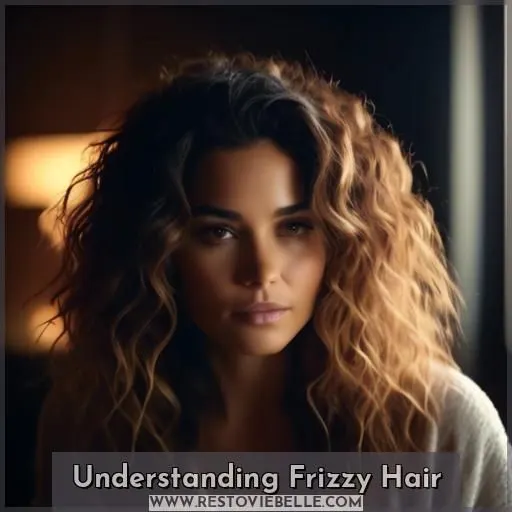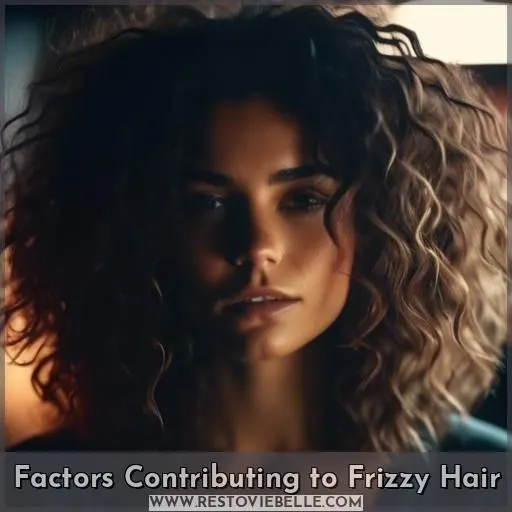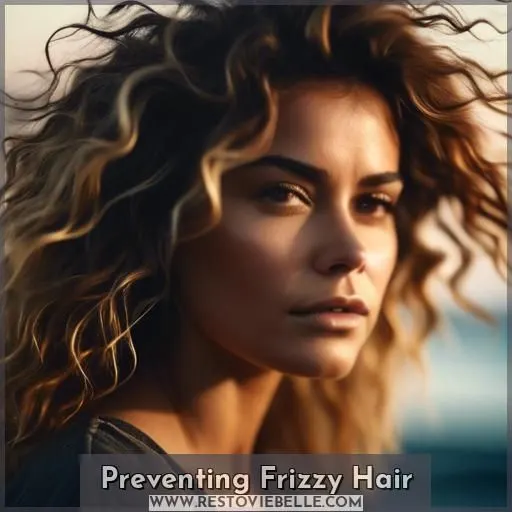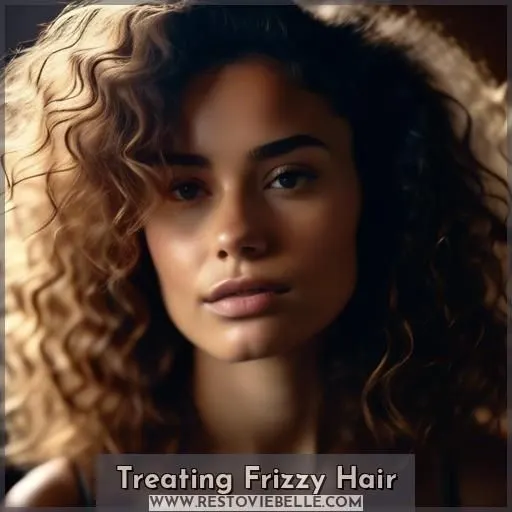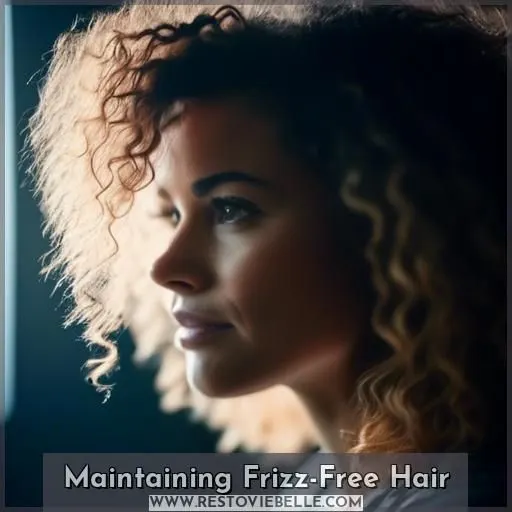This site is supported by our readers. We may earn a commission, at no cost to you, if you purchase through links.
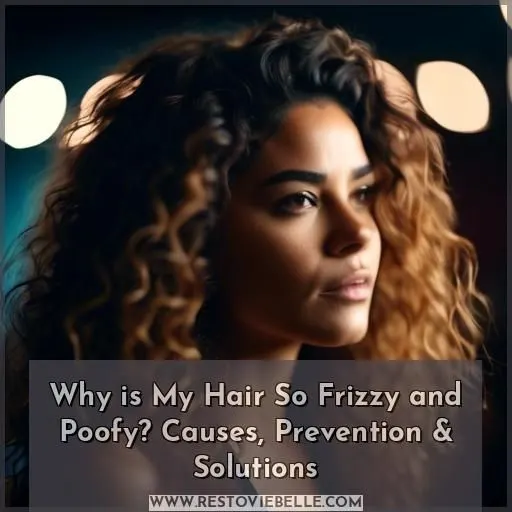 Battling frizzy, poofy hair? Like a tangled web, the causes lurk beneath the surface.
Battling frizzy, poofy hair? Like a tangled web, the causes lurk beneath the surface.
From environmental aggressors to genetic predispositions, your tresses’ texture holds the key.
Unlock the secrets to taming those unruly locks with targeted solutions.
Embrace the right routine, styling techniques, and treatments to reclaim smooth, sleek strands.
Table Of Contents
Key Takeaways
- Frizzy hair is caused by a combination of factors, including environmental humidity, hair porosity, and the amount of damage to the hair.
- The cuticle layer of the hair, which is the outermost layer, plays a crucial role in determining the hair’s susceptibility to frizz. When the cuticle is damaged, it allows moisture to escape, leading to frizz.
- The thickness of the hair fiber, level of curl, and amount of damage to the hair also contribute to frizzy hair.
- To combat frizzy hair, it is essential to maintain a consistent hair care routine, use quality hair products, and avoid products containing waxes, gels, or creams. Regular trims can also help reduce frizz by removing split ends.
- Environmental factors, such as humidity and wind, can significantly impact the hair’s ability to maintain moisture and contribute to frizz. Adjusting your hair care routine based on the season and using anti-humidity products can help reduce frizz caused by environmental factors.
- Hair fiber diameter and level of curl play a significant role in determining the hair’s frizziness. Fine hair tends to frizz more easily due to its higher porosity, while coarse hair may frizz due to its lack of moisture retention. Understanding your hair’s unique needs and tailoring your hair care routine accordingly can help reduce frizz.
- Regular trims, moisturizing treatments, and the use of quality hair products designed for your specific curl type and porosity can help reduce frizz and keep your hair looking smooth and healthy. Avoiding harsh styling products and heat damage is also essential.
- Split ends, cuticle loss, and breakage can all contribute to frizzy hair. Maintaining healthy hair and scalp through regular trims, moisturizing, and using quality hair products can help reduce frizz caused by damage.
Why is My Hair So Frizzy and Poofy?
Your hair might be frizzy and poofy due to a combination of factors like humidity, damage, and lack of moisture, which cause the hair cuticles to open up and absorb moisture from the air. To combat this, use moisturizing products, limit heat styling, and apply techniques that reduce friction and seal in moisture.
Understanding Frizzy Hair
Frizzy hair is a common concern for many, and it can be frustrating to deal with. But what exactly causes frizzy hair? The answer lies in the hair’s cuticle, which is the outermost layer of the hair shaft. When the cuticle is damaged, it raises and allows moisture to escape, leading to frizz.
Hair porosity plays a significant role in frizzy hair. Highly porous hair absorbs moisture quickly, while low porosity hair retains moisture for longer. This difference in porosity affects the hair’s ability to maintain moisture, leading to frizz.
Hygral fatigue, or the fatigue of the hair’s ability to absorb and release moisture, can also contribute to frizzy hair. This occurs when the hair’s cuticle is constantly raised and lowered, causing the hair to become more prone to frizz.
Frizz management is crucial for maintaining healthy hair. Hair humectants, such as glycerin and hyaluronic acid, can help attract and retain moisture, reducing frizz. Cuticle health is also essential, as a healthy cuticle allows the hair to maintain moisture and reduces frizz.
Processed hair, such as heat-damaged hair, relaxed hair, and colored hair, can all contribute to frizzy hair. Damaged hair, with split ends, also increases the likelihood of frizz. Dry hair is more prone to frizz, as it has a harder time retaining moisture.
To combat frizzy hair, it’s essential to maintain a consistent hair care routine, use quality hair products, and avoid products containing waxes, gels, or creams. Regular trims can also help reduce frizz by removing split ends.
In the realm of frizzy hair, it’s not merely about finding the right products; it’s about understanding your hair’s unique needs. By tailoring your hair care routine towards your hair’s porosity, humidity, and hydration levels, you can unlock the secrets to frizz-free hair.
Factors Contributing to Frizzy Hair
Your hair’s frizziness may be due to environmental factors, the thickness of your hair fibers, its level of curl, or the amount of damage it has sustained. The more damage to your hair or the more coarse and curly it is, the more likely it will frizz.
Environmental Factors
Environmental factors, such as seasonal changes and weather conditions, can significantly impact your hair, leading to frizziness.
- Humidity control: Humidity can cause your hair to absorb excess moisture, leading to frizz. Use anti-humidity products, such as lightweight creams or serums, to create a barrier between your hair and the environment.
- Wind protection: Wind can cause your hair to become frizzy and tangled. Use hair serums or oils to protect your hair from wind damage.
- Seasonal changes: In the winter, wearing warm hats can cause your hair to become frizzy due to sweat. In the summer, UV rays can dry out your hair, making it more prone to frizz.
- Weather-appropriate hair care: Adjust your hair care routine based on the season. For example, use a hydrating shampoo and conditioner in humid weather, and a deep conditioner weekly to maintain moisture balance.
- Hair styling tips: Avoid rubbing your hair vigorously with a towel, as it can create friction and frizz. Instead, gently squeeze excess water from your hair, or use a microfiber towel to blot the hair.
Hair Fiber Diameter
Your hair’s fiber diameter plays a significant role in determining its frizziness.
Fine hair tends to frizz more easily due to its higher porosity, which allows moisture to escape and causes raised hair scales.
Coarse hair may also frizz due to its lack of moisture retention.
To combat frizz, consider your hair’s natural texture, scalp health, and genetics when selecting hair products and styling techniques.
Regularly cleanse your hair to avoid product buildup.
Maintain a balanced diet to support hair growth and prevent hair loss.
Level of Curl
Level of Curl is a significant factor that contributes to frizzy hair. The curlier your hair, the more prone it’s to frizz due to the dry, coarse texture of curly hair. This is because curly hair has a natural tendency to absorb moisture from the environment, which can cause the cuticle to lift and allow moisture to escape, leading to frizz.
To combat frizzy hair, it’s essential to understand your hair’s curl type and porosity. Different curl types require different care and product selection. For example, high porosity hair has raised cuticles that can absorb moisture but can’t hold on to it, making it prone to frizz and breakage. Medium porosity hair retains adequate moisture and reacts well to chemical treatments, while low porosity hair doesn’t retain moisture well and is almost water-resistant.
When it comes to managing frizzy hair, a well-rounded hair care routine is crucial. This includes regular trims to remove split ends, moisturizing treatments, and the use of quality hair products designed for your specific curl type and porosity. Avoiding harsh styling products and heat damage is also essential.
For those with curly hair, it’s recommended to use curl-defining, frizz-fighting styling creams and gels that provide hold and hydration. Additionally, using a diffuser when blow-drying can help maintain the natural texture of curly hair and reduce frizz.
In summary, understanding your hair’s curl type and porosity is key to managing frizzy hair. A well-rounded hair care routine, including the use of appropriate products and avoiding damaging styling practices, can help reduce frizz and keep your hair looking smooth and healthy.
Amount of Damage
- Split Ends: These are the ends of your hair that have been damaged, often from heat styling or harsh chemicals. They can cause frizz by allowing moisture to escape from the hair shaft.
- Cuticle Loss: When the protective layer of your hair (the cuticle) is damaged, it allows moisture to escape, leading to frizz.
- Breakage: Damage to the hair shaft can result in breakage, which contributes to frizz.
- Hair Porosity: The ability of your hair to absorb and retain moisture affects its susceptibility to frizz. High porosity hair can absorb moisture quickly, but also loses it easily, leading to frizz.
To combat frizzy hair, focus on maintaining healthy hair and scalp. Regular trims, moisturizing, and using quality hair products can help reduce frizz. If you’re unsure how to care for your hair, consider seeking professional help or watching hair tutorials for guidance.
Preventing Frizzy Hair
To prevent frizz, you can start by adjusting your hair care routine, styling techniques, and making some lifestyle changes. It’s important to handle your hair with care, and avoid products that contain harsh chemicals or dehydrating ingredients.
Hair Care Routine
To prevent frizzy hair, follow a hair care routine tailored to your needs:
- Choose products based on your hair porosity.
- Prioritize deep conditioning to enhance hair elasticity.
- Be mindful of hair growth by trimming regularly.
- Combat hair breakage with gentle brushing techniques.
Styling Techniques
When it comes to preventing frizzy hair, styling techniques play a crucial role. Here are three key strategies to keep your hair looking sleek and smooth:
- Product Recommendations: Choose styling products that are designed to combat frizz. Look for formulas that contain natural oils, like argan or jojoba, which help to lock in moisture and keep your hair hydrated.
- Styling Tools: Invest in a high-quality blow dryer with a cool shot button, which can help set your style and reduce frizz. Opt for ceramic or tourmaline plates when straightening or curling your hair to minimize damage.
- Protective Styles and Upkeep Tips: Braids, twists, and updos can help protect your hair from environmental factors and damage. Remember to keep your hair moisturized and use protective styles sparingly to avoid breakage. Regular trims and professional treatments can also help maintain frizz-free hair.
Lifestyle Changes
To prevent frizzy hair, consider making lifestyle changes. Here are five ways to achieve this:
- Healthy Lifestyle: Eat a balanced diet rich in vitamins and minerals, stay hydrated, and get enough sleep.
- Nutritional Supplements: Consider taking supplements to address any nutritional deficiencies that may affect your hair’s health.
- Hormonal Changes: Monitor and manage hormonal changes that can impact hair health, such as menopause or pregnancy.
- Medication Side Effects: Be aware of medication side effects that may affect hair health and discuss alternatives with your doctor.
- Stress Management: Practice stress management techniques, such as meditation or yoga, to reduce stress-related hair damage.
Treating Frizzy Hair
Tackling frizzy hair requires a multi-pronged approach, including deep conditioning with hair masks and serums, nourishing with hair oils, strategic haircuts and styling, and seeking professional treatments for severe cases.
As you explore these options, consider your hair type, damage level, and lifestyle to find the best solutions for your specific needs.
Hair Masks and Serums
Hair masks and serums are excellent treatments for frizzy hair. They can be used to deep condition and provide extra moisture.
- Choose the right ingredients: Look for hair mask ingredients like dimethiconol and avocado oil that help lock in moisture. Serums with natural oils can also provide a protective layer against humidity.
- Experiment with homemade remedies: You can make your own hair mask using ingredients like bananas, honey, and olive oil. These natural solutions can be as effective as store-bought products.
- Consistency is key: Regular use of hair masks and serums can help maintain frizz-free hair. Incorporate them into your weekly routine for best results.
Hair Oils
Discover the power of hair oils in your quest for frizz-free locks. Here are four ways hair oils can benefit your hair:
- Hair Oil Benefits: Hair oils can moisturize your hair, protect it from damage, and add shine.
- Hair Oil Ingredients: Look for natural oils like coconut and jojoba, or silicone-based oils for added benefits.
- Hair Oil Types: Choose the right oil for your hair type, whether it’s straight, curly, or damaged.
- Hair Oil Application: Apply the oil to damp hair before styling or use it as a finishing touch.
Haircuts and Styling
In the battle against frizz, your haircut is your sword. Consider these styles:
- Layered Cuts: They add bounce and reduce weight, letting your locks flow freely.
- Bob Haircuts: A sleek choice that minimizes puffiness.
- Lob Haircuts: The longer cousin of the bob, offering versatility without the frizz.
- Curly Haircuts: Embrace your curls with cuts that enhance, not ensnare. And for an extra boost, explore hair extensions for volume and control.
Professional Treatments
Professional treatments can help combat frizzy hair. Here are five options:
- Hair Straightening: Keratin treatments, smoothing treatments, and chemical straightening can reduce frizz by smoothing hair cuticles.
- Hair Relaxers: Chemical treatments that relax curls can reduce frizz, but overuse can damage hair.
- Hair Texturizers: These treatments can enhance curls and reduce frizz, but they can also damage hair if overused.
- Chemical Treatments: Some chemical treatments, like those containing sulfates or parabens, can damage hair and increase frizz.
- Professional Help: Consulting with a hair stylist or dermatologist can help you find the best treatment for your hair type and concerns.
Maintaining Frizz-Free Hair
Regular trims remove split ends and damaged hair, reducing frizz. If home care doesn’t tame your frizz, don’t hesitate to seek professional help from a hairstylist or trichologist.
Regular Trims
Regular trims are crucial for maintaining healthy, frizz-free hair.
Trimming your hair every 6 to 8 weeks is recommended for curly hair, but the frequency may vary depending on your hair growth rate and overall health.
Regular trims help prevent split ends and breakage, which can lead to frizz.
By removing damaged ends, you promote healthier hair growth and improve the overall appearance of your hair.
It’s essential to keep your hair in optimal condition, especially if it has been subjected to chemical processing like coloring.
Trimming not only makes your hair look fresh but also gives the illusion of fuller, thicker hair.
Regular trims also make your hair easier to style using heat, as damaged ends respond less well to heat treatment.
Professional Help
Seeking expert advice? Consulting specialists can be your secret weapon against the frizz frenzy.
- Professional consultations offer personalized solutions, turning your hair woes into wows.
- Expert advice from hair care professionals ensures you’re using the right products and techniques.
- Salon recommendations keep you ahead of the curve, with the latest in frizz-fighting trends. Say goodbye to bad hair days, and hello to liberation!
Frequently Asked Questions (FAQs)
How often should I wash my hair to prevent frizz?
You should wash your hair every 2-3 days to prevent frizz. Overwashing strips natural oils, leading to dryness and frizziness.
Can using a hairdryer cause frizz?
Hairstylist Tip: Using a hairdryer improperly can absolutely cause frizz. Blast heat too close or with high heat settings? Frizzy locks await! Go easy – use the cool shot button and keep the dryer 6+ inches away from your strands.
Is it possible to have naturally frizz-free hair?
Sadly, no. Due to genetics and environment, truly frizz-free hair is an unrealistic dream. But with the right routine and products, you can tame those wild strands into smooth submission.
Can certain hairstyles increase frizz?
Yes, certain hairstyles can worsen frizz. Tight ponytails or buns pull hair taut, disrupting cuticles and causing frizz.
How does humidity affect frizzy hair?
A humid day means a frizz-fest, my friend. Humid air allows hair to absorb moisture, causing cuticles to swell and strands to puff out uncontrollably.
Conclusion
Frizzy hair affects millions worldwide, so you’re not alone in your quest for smoother strands.
By identifying the root causes – whether environmental, genetic, or damage-related – and implementing a targeted routine with the right products and techniques, you can reclaim control over your frizzy, poofy hair.
Consistency and patience are key, but the journey towards sleek, manageable tresses is within reach.
